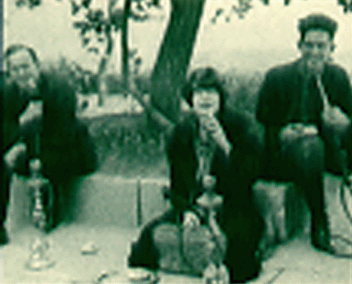
"Grass" was produced in 1924 by filmmakers Marian C. Cooper and Ernest B. Schoedsack (creators of "King Kong"). They were accompanied by journalist-cum-spy Marguerite Harrison.

| Grass
"Grass" was produced in 1924 by filmmakers Marian C. Cooper and Ernest B. Schoedsack (creators of "King Kong"). They were accompanied by journalist-cum-spy Marguerite Harrison. |
By
Iraj Bashiri
© 2002, Iraj Bashiri
The Bakhtiari tribe divides into two main branches: the Haft Lang and the Chahar Lang. The Haft Lang consists of 33,493 households. The Chahar Lang consists of 2,825 households. Each tribe further divides into subtribes. The Bakhtiaris are Shi’ite Muslims. In difficult spots you find them seek assistance ("Yo Ali!") from Saint Ali, the First Saint of the Shi'ites.
The branch of the Il-i Bakhtiari (Bakhtiari tribe) that is depicted in the film is called the Baba Ahmadi. It migrates between Ahwaz and Isfahan, crossing the ice-cold water of the Karun River and the snow-clad peaks of the Zagros Mountain. They undertake this journey twice a year. This branch numbers about 50,000 individuals. The Il-Khan (supreme tribal chief) divides them into groups of approximately 5,000 and assigns each group an Il-Rah (tribal route).
The journey begins around the 21st of March (Persian New Year), near the city of Ahwaz. The first hurdle is the Karun River that is about half a mile wide. Women, children and young animals cross on puffed-up goatskins made into a raft. Others use single or double skins to cross themselves and their animals, which number about half a million.
To cross the river, the Bakhtiaris throw themselves and their livestock into the whirlpools. There they mill around until the centrifugal force of the water throws them out towards the opposite shore. Some men cross the river more than eight times a day to help others carry their flock, children and household utensils over to the other shore.
Crossing the river takes five or six days usually accompanied by many casualties. These include sheep and other livestock being swept away in the whirlpools, as well as the young men who drown trying to save them. Some elderly who decide against crossing the river stay behind. They have to fend for themselves alone.
The next hurdles are several mountain ranges. These mountains are crossed one after the other in a space of a few days during which the Bakhtiaris fan out and graze their flock around the rivers that take source in the mountains. The last range is called Zardeh Kuh. Over 13,000 feet in height and still covered by snow, the Bakhtiaris must cross it before they can reach the green pastures around Isfahan in the center of the plateau.
Here, the Bakhtiaris leave their equipment, tents, carpets, cooking utensils, and the other amenities that they had recently used in the nearby villages for use after they return. With them they take only the absolute necessities, i.e., their flocks, horses, donkeys, and mules, the main sources of their survival.
The Bakhtiaris are a truly hardy people. Even on the snow, they do not wear shoes, which they believe belong to the world of the city dwellers. When they must pass a place where deep snow needs to be packed, they "break trail" in the snow with their bare feet to ease the passage for the rest of the tribe. The entire journey takes about 30 days.
In general, the Bakhtiaris live six months in their qishlaq (winter quarters) around Ahwaz on the Khuzistan plain and four months in their yaylaq (summer quarters) around Isfahan. The other two months they travel, grazing their flocks on the way. About fifteen days of each journey is truly rough. At times, they find themselves sleeping on the snow-covered mountain without adequate clothing.